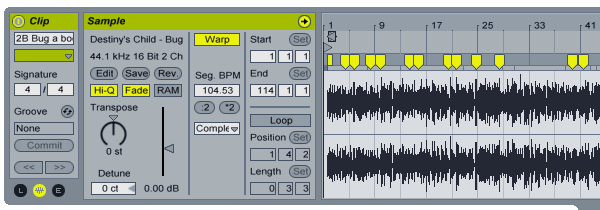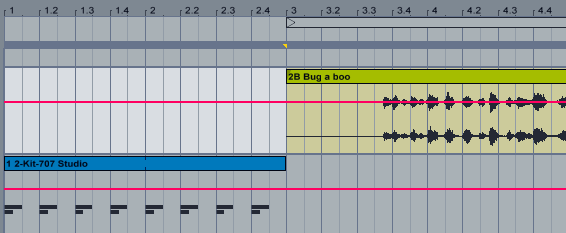Export from Ableton Live to Rekordbox
A lot of DJs wish they could do the warping from Ableton Live also in their other favourite DJ software. For example, I would like to be able to warp acapellas in Rekordbox to have them quantized and with the correct BPM for quick and tight mixing. On the other hand you don’t want to warp the same track in multiple programs if you are using a combination of software, e.g. Ableton Live, Traktor, Rekordbox.
With a simple trick you don’t need to and can export your warped tracks from Ableton Live to Rekordbox and have Rekordbox automatically set the beat markers.
Warp the Acapella in Ableton Live
Let’s start with an acapella that needs warping. I’ve taken on Destiny’s Child – Bug a boo and placed the warp markers required to make the acapella run steady and on the beat. When I normally do this I already use a kick drum from Ableton Live next to the metronome. It gives me a better idea on how it will sound when using the acapella in combination with a house track and makes the warping for me easier. In this case I reused that same kick drum in the export.

At Reference Beats
To make Rekordbox detect the ‘beatgrid’ from Ableton Live I’ve put 8 beats (2 bars) in front of the acapella and 8 beats at the end as a reference. So in my arrangement view it looks like below:

Make sure to put some time between the end of the actual acapella and the last beats so you have time to stop the track or put down the channel fader on your mixer. Because the song will continue to play and run into the 2 bar of beats, which may surprise you and the audience…
Export from Ableton Live
Next step is to export the track. Make sure to keep the project tempo close to the original of the acapella to prevent lots of tempo artefacts. Also match the volume between the beat and acapella and use normalize on export. If you don’t match the volumes you may end up with a heavy beat and quiet acapella.
Import the Acapella into Rekordbox
Import the wav file into Rekordbox and let Rekordbox analyze the acapella. In my case it was directly perfect and there was no need to change the beatgrid.

It is easy to check, by verifying that the beatgrid is aligned with the first 8 beats and also correct on the last 8 beats at the end of the track. If the beatgrid is not correctly aligned you can do this by using the first and last 8 beats as reference.

Add Cue Points and Loops
To make the acapella easy to use I make a 8 beat loop of the first 8 beats and store it into memory. You can use this to quickly pitch the acapella and match it with the currently playing track. Although with the new 1 decimal precise BPM value on the CDJ-2000 you may not even need this. Next I make a cue point at the start of the acapella and store that also to memory.
Do I need 8 beats at both ends?
To compare the results I’ve also exported the warped acapella without the 8 beats at the beginning and end. In that case Rekordbox wasn’t able to detect the correct beatgrid.

I’ve also tested the track with only 8 beats at the beginning and Rekordbox did detect the beatgrid correct but not as tight as it did with 8 beats at both ends. It came to a BPM value of 104.04 instead of 104 exactly. So the 8 beats at the end are required to make it perfect and help you in case you need to set the beatgrid manually.
I’ve done this with an acapella since I am an acapella man, but it can also be a synth loop or any other organic material.
Trackback from your site.